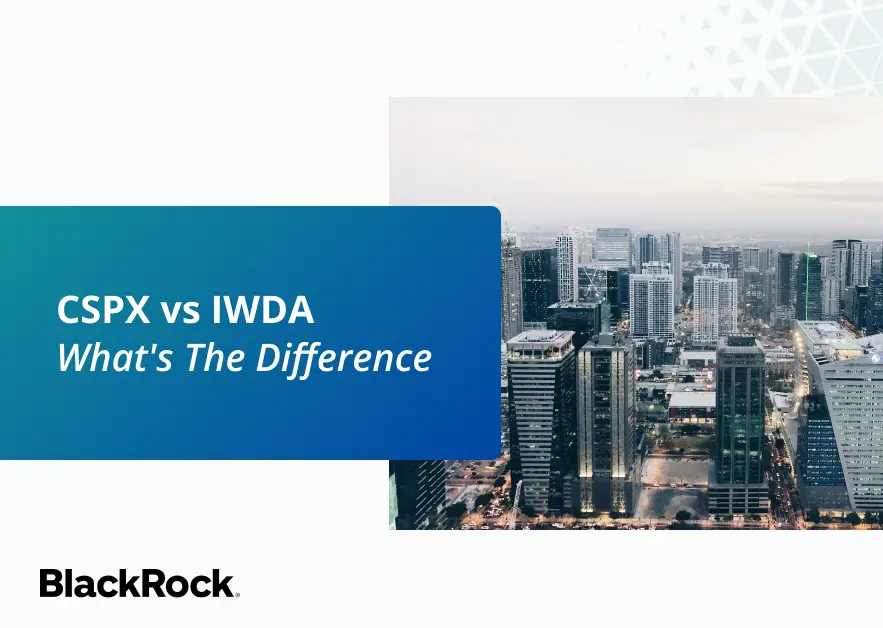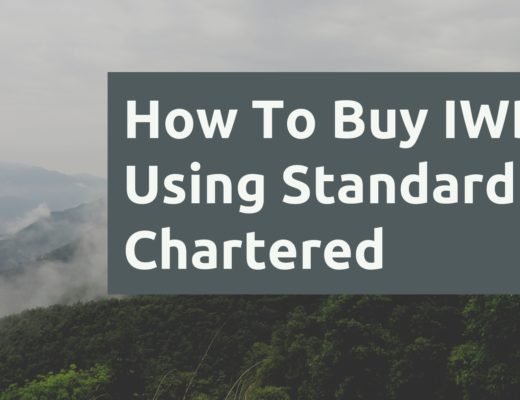Last updated on February 4th, 2022
Both CSPX and IWDA are funds under the iShares Core ETFs which are designed to provide you with immediate access to a diverse basket of stocks.
With both ETFs being a decent choice to diversify your portfolio, you may be wondering what are the key differences between these two indices, and which should you invest in?
Here is what you need to know to help you decide:
Contents
The difference between CSPX and IWDA
CSPX is a fund that tracks the performance of the Standard & Poor’s 500 Index (S&P 500), a benchmark made up of the biggest 500 large-cap stocks from the US. In contrast, IWDA is a fund that tracks the performance of the MSCI World Index, which includes 1560 holdings from across 23 different countries with different market caps.
The funds thus differ in the type of markets they expose you to, with the main difference between the number of countries they pull stocks from.
The similarities between CSPX and IWDA
The manager of both funds is BlackRock, one of the largest asset managers in the world. BlackRock has over $5 trillion in assets under management and offers a wide range of investment options for investors such as these two indices.
Both funds are also traded in USD on the London Stock Exchange (LSE) and are accumulating funds. This means that any dividends earned from the fund will automatically be reinvested into itself, increasing the value of your investment.
If you’re wondering what’s the difference between accumulating and distributing funds, you can view this comparison to find out more.
CSPX and IWDA are Ireland-Domiciled ETFs as well, benefitting from the US/Ireland tax treaty rate of only 15%. In contrast, if you were to invest in an ETF on the US stock market, you will have to pay a tax of 30% on dividend income as Singapore does not have a tax treaty with the US.
What’s more, you get to save on the rather hefty US estate tax as well.
As such, investing in CSPX and IWDA will be better for you compared to their US counterparts as you will save 15% from dividend income taxes.
Unit Price
The unit price of each ETF is the price you’ll need to pay for 1 unit.
CSPX and IWDA have vastly different unit prices, with CSPX being almost more than 5 times more expensive than IWDA as of 15th December 2021.
| CSPX | IWDA | |
|---|---|---|
| Estimated Unit Price | $476 USD | $87 USD |
This makes IWDA a lot more accessible to invest in if you have a smaller amount you are able to invest in! IWDA is thus a cheaper way to diversify your portfolio if you are newer to investing.
Country diversification
CSPX includes US companies that fall under one of the 500 largest companies from the US that have a market capitalization of at least USD 11.8 billion.
On the other hand, IWDA includes holdings from 23 different developed countries. Here is the geographical breakdown in percentage of the shares IWDA has a stake in.
| Country | Weightage |
|---|---|
| United States | 68.32% |
| Japan | 6.41% |
| United Kingdom | 4.09% |
| France | 3.29% |
| Switzerland | 3.20% |
| Germany | 2.80% |
| Australia | 2.52% |
| Netherlands | 1.98% |
| Sweden | 1.43% |
| Other 14 developed countries* | 4.89% |
*Austria, Belgium, Canada, Denmark, Finland, Hong Kong, Ireland, Israel, Italy, New Zealand, Norway, Portugal, Singapore, Spain
What does this mean for investors like you and me?
IWDA may be a better option if you are looking for a greater diversity of countries to invest in. Meanwhile, if you have a high conviction of the US market, CSPX may be a better option as all of its holdings fall in the US.
Types of stocks
CSPX contains the top 500 large cap companies from the US while IWDA contains the 1560 holdings which include both large and mid cap companies in developed countries.
A large cap company is one that has a market capitalisation of more than $10 billion.
Meanwhile, a mid cap company has a market capitalisation between $2 to $10 billion.
Investopedia
The market cap of a company can be determined by multiplying the stock price by the number of outstanding shares.
This is because of the indices that both ETFs track. If you’re interested in finding out more about the differences between the MSCI World Index and the S&P 500, here’s a comparison for you.
Top Sectors
Here is a comparison between the top 5 sectors that are found in CSPX and IWDA as of 3rd December 2021.
| CSPX | IWDA |
|---|---|
| Information Technology (IT) 28.9% | Information Technology (IT) 23.5% |
| Consumer discretionary 12.9% | Financials 13.3% |
| Healthcare 12.8% | Consumer Discretionary 12.5% |
| Financials 10.9% | Healthcare 12.3% |
| Communication 10.3% | Industrials 10.2% |
Both funds have very similar weights, with IT being the top sector of both CSPX and IWDA with 28.9% and 23.5% respectively.
Since IT has been one of the fastest growing sectors in the past few years, the difference in the percentage of holdings in IT may skew in the favour of CSPX. This will be explored further in the difference in performance below.
Apart from a few slight differences, either one of the funds will give you a fairly balanced diversification, with a major portion of your investment in IT.
Top holdings
Now, let us take a look at the top 5 holdings of each of the funds.
| CSPX | IWDA |
|---|---|
| Apple 6.6% | Apple 4.7% |
| Microsoft 6.3% | Microsoft 3.9% |
| Amazon 3.8% | Amazon 2.6% |
| Alphabet Inc A (Google) 2.2% | Tesla 1.5% |
| Tesla 2.1% | Alphabet Inc A (Google) 1.4% |
Again, we can see that both CSPX and IWDA have very similar top holdings. The only difference is the stock allocation, with CSPX having a slightly higher allocation in these companies.
As these companies have been powerhouses in growth in the last 5-10 years, this has given CSPX a bit of an edge in growth as well.
Performance
Both funds have performed very well in the past 5 years, with CSPX having an average annual return of 17.4% while IWDA having a 13% average annual return.
If you were to purchase both funds 5 years ago, you would be up 123.7% for CSPX (more than double your initial investment). IWDA on the other hand, would have returned 82.4%.
As explained above, CSPX has outperformed IWDA by a small margin as it has a greater proportion of its holdings in the top US companies. These US companies have led the growth in the global economy, especially with major companies like Apple and Microsoft who are the biggest in the world.
However, past performance does not indicate future returns, so it will be good to do your own research first, before investing in either fund!
Expense ratio
On top of the trading commissions you’ll need to pay to the broker, you will have to pay an expense ratio to the fund manager as well.
The expense ratio is charged by the fund manager to cover the costs of running the fund.
Based on the value of your assets in the fund, you will be charged an annual fee.
Here are the expense ratios for these 2 funds:
| CSPX | IWDA | |
|---|---|---|
| Expense Ratio | 0.07% | 0.20% |
The expense ratio of CSPX is slightly lower than IWDA. This means that over time, you would be paying lower fees if you were to invest in CSPX as compared to IWDA.
As such, you may want to take this into consideration when deciding which to invest in!
Liquidity
If you are looking to actively trade using these ETFs, you may want to look at their liquidity. One of the indicators you may want to look at is the ETF’s average trading volume.
| CSPX | IWDA | |
|---|---|---|
| Average Trading Volume | 69,506 | 344,762 |
IWDA has a much higher trading volume than CSPX. However, as both of these funds are listed in the LSE, they are much lower compared to the S&P 500 ETFs which are listed on the NYSE.
Verdict
Here is a comparison between CSPX and IWDA:
| CSPX | IWDA | |
|---|---|---|
| Type of stocks | Large cap US equities | Large and mid cap equities from 23 developed countries |
| Unit price | Higher | Lower |
| Number of holdings | 505 | 1560 |
| Top sectors | Information Technology (IT) 28.9% Consumer discretionary 12.9% Healthcare 12.8% Financials 10.9% Communication Services 10.3% | Information Technology (IT) 23.5% Financials 13.3% Consumer discretionary 12.5% Healthcare 12.3% Industrials 10.2% |
| Exposure to global economy | Good | Slightly stronger |
| Expense ratio | Lower | Higher |
| Liquidity | Lower | Higher |
| Past performance | Stronger | Weaker |
So which index should you choose to invest in?
Choose CSPX if you are confident in the US economy.
CSPX tracks the S&P 500 which has historically been one of the best performing indices. Tracking the very best companies in the US, you are theoretically buying into the US economy as a whole.
CSPX has survived and eventually climbed to all-time highs after every major crash in the past decade. As such, investing in CSPX is a rather safe way of buying into an already diversified portfolio.
If you are looking for flat numbers, CSPX also just outperforms IWDA in its average annual returns. With a higher concentration in the US market, as the global economy continues to be led by the US’s economic growth, CSPX will continue to outperform IWDA in the long run.
Despite this, you may want to take note that CSPX is still very concentrated in just the US.
Choose IWDA if you want a more diversified portfolio across multiple countries.
IWDA has more than 3 times the amount of holdings than CSPX and is diversified across 23 different developed countries. Even though it may still have the majority of its holdings in the US (68.32%), it is still more diversified than CSPX which is limited to only the US.
Despite not performing as well as CSPX, IWDA has also similarly climbed to all time highs after major crashes. An average annual return of 13% is still a healthy amount for a long term investment.
IWDA is also more insulated against a major crash in the US stock market as it still has over 30% of its holdings held in other countries. This makes IWDA a relatively safer investment if you are slightly more risk averse.
In the event that another country outperforms the US, you will still be able to be exposed to it, as compared to CSPX which is solely concentrated in the US!
Conclusion
Both funds allow you to purchase into a diversified portfolio that can benefit from the growth in the global economy.
The main considerations you should have include:
- How confident you are in the US market
- How diversified you want to be outside of the US market
- Your personal risk level

Do you like the content on this blog?
To receive the latest updates, you can follow us on our Telegram channels (Personal Finance or Crypto) and Facebook.
Are you passionate about personal finance and want to earn some flexible income?





